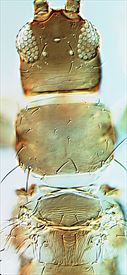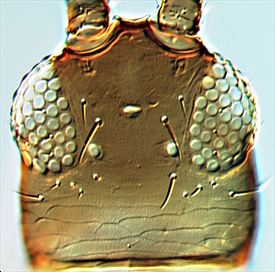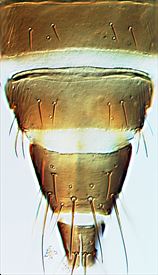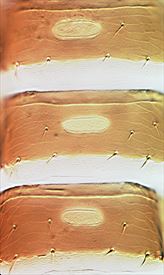Distinguishing features
Both sexes usually micropterous. Female colour variable; brown, with thorax, femora, and middle and hind tibiae pale brown or yellowish; head and thorax sometimes yellow in contrast to brown abdomen; fore tibiae and tarsi, antennal segment III, and sometimes base of antennal segment IV yellow; fore wing rudiment pale when very short, shaded apically in hemimacropterae; fully developed wing pale at base but brown in distal three-quarters; major setae brown. Head slightly longer than wide, projecting in front of eyes; ocelli reduced; 1st ocellus often divided; postocular setae not arising in a straight line. Antennae 7-segmented (rarely 8-segmented), III and IV each with forked sense cone. Pronotum with 2 or 3 pairs of posteromarginal setae; surface faintly sculptured. Metanotum irregularly reticulate medially. Fore wing rudiment oval; 1st vein with 3 setae. Tergites with 4–6 lines of sculpture medially, setae relatively long; ctenidia not developed on tergite V, weak on VI, present on VII and VIII; tergite VIII with posteromarginal comb irregular, variable. Pleurotergites with 2 or 3 discal setae. Sternites with 5–7 discal setae. Fully winged females not common, median tergal setae short, tergites V–VIII with ctenidia.
Male similar to female but smaller; sternites III–VII with transverse pore plate.
Related species
There are 13 species of the genus Thrips recorded from New Zealand, of which five comprise an endemicgroup, out of a total of 280 species worldwide (Mound & Masumoto, 2005). All members of Thrips genus have paired ctenidia on the tergites, and on tergite VIII these are postero-mesad to the spiracles, and these species also lack ocellar setae pair I in front of the first ocellus. In contrast, Frankliniella species have ctenidia on tergite VIII antero-lateral to the spiracles, and a pair of setae is always present in front of the first ocellus. T. phormiicola is one of the five New Zealand endemic members of this genus that share the presence of three pairs of posteromarginal setae on sternite II. As in T. obscuratus, the number of antennal segments varies from 7 to 8. However, the head of T. phormiicola is relatively long, resembling the head shape of several unrelated Thripidae that live on grasses. The number of sternal discal setae is less than in T. obscuratus, and the posteromarginal comb on tergite VIII is very reduced. In T. obscuratus micropterae the ocelli are well developed and the median tergal setae are as small as in macropterae. However, in T. phormiicola the micropterae have very reduced ocelli, and the median tergal setae are as long as the lateral ones.
Biological data
The host plant of this thrips, Phormium tenax, is widespread in New Zealand, and is also native to the Chatham and Auckland islands. T. phormiicola has also been collected from P. cookianum.
Distribution data
Known only from New Zealand, and collected in both North and South Islands (AK, TO, WI, WN / NN, MB and WD).
Family name
THRIPIDAE, THRIPINAE
Species name
Thrips phormiicola Mound
Original name and synonyms
Thrips phormiicola Mound, 1978: 618.
References
Mound LA (1978) Five new species of Thripidae (Thysanoptera) endemic to New Zealand. New Zealand Journal of Zoology 5: 615–622
Mound LA & Masumoto M (2005) The genus Thrips (Thysanoptera, Thripidae) in Australia, New Caledonia and New Zealand. Zootaxa 1020: 1–64
Martin NA & Mound LA (2004) Host plants for some New Zealand thrips (Thysanoptera: Terebrantia). New Zealand Entomologist 27: 119–123
Mound LA & Walker AK (1982) Terebrantia (Insecta: Thysanoptera). Fauna of New Zealand 1: 1–113.





